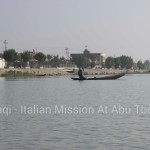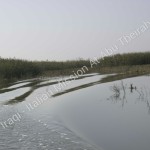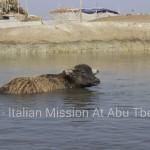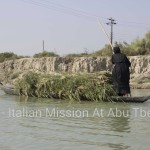LE PALUDI
Le paludi mesopotamiche o Paludi irachene sono una zona umida situata nel sud dell’Iraq e in parte nel sud-ovest dell’Iran e nel Kuwait. Si tratta di un paesaggio acquatico raro nel deserto, che fornisce l’habitat ideale per gli arabi delle paludi ma anche per una fauna selvatica. Nell’Iraq esse toccano tre regioni: Thi-Qar, Missan e Bassora. Le genti che abitano queste aree sono i “discendenti” dell’antico popolo sumero che popolava la Mesopotamia migliaia di anni fa e vivono in piccoli centri abitativi costituiti principalmente da particolari case galleggiante che spesso sono raggiungibili solamente in barca.
LE PALUDI PRINCIPALI
Le paludi si dividono in tre aree principali, quelle centrali si trovano tra il Tigri e l’Eufrate e ricevono acqua dallo Shatt al-Muminah e Majar al Kabir-sud , mentre le Paludi di Hammar si trovano a sud dell’Eufrate. Qui si trova il lago di Hammar che è il più grande corpo idrico delle paludi. Infine le paludi di Hawizeh sono situate ad est del Tigri. Una parte di essa confluisce nell’Iran, conosciuta come Al-Azim Hawr ed è alimentata dal fiume Karkheh. Nel 1950 è iniziata la bonifica delle paludi della Mesopotamia che si è conclusa con la caduta del regime di Saddam Hussein nel 2003, ma la siccità insieme alla costruzione della diga hanno ostacolato il processo di recupero.
POPOLAZIONE
Nel 1950, c’erano circa 500.000 arabi delle paludi. Questa popolazione si è ridotta a circa 20.000 in seguito alla bonifica e alle violente rappresaglie di Saddam, e tra 80.000 e 120.000 fuggirono nel vicino Iran. A partire dal 2003, gli arabi delle paludi hanno iniziato a tornare nel loro habitat originario.
FAUNA
Le paludi ospitano 40 specie di uccelli e diverse specie di pesci, esse erano un tempo patria di milioni di volatili e sosta di numerosi uccelli migratori, tra cui fenicotteri, pellicani e aironi. Numerose sono le specie in via di estinzione come: l’anatra marmorizzata, la Bassora cannaiola, il corvo mesopotamico; altre invece sono estinte come il lupo grigio e l’istrice indiano.
THE MARSCHES
The Mesopotamian marshes or Iraqi Marshes are a wetland located in the south of Iraq and partly in the southwest of Iran and Kuwait. It is a rare aquatic landscape in the desert, which provides an ideal habitat for the Marsh Arabs but also for wildlife. In Iraq they reach three regions: Thi-Qar, Missan and Basra. The people who inhabit these areas are the “the descendants” of the ancient Sumerian people that inhabited Mesopotamia thousands of years ago and live in small population centers consisting mainly of special houseboats which are often accessible only by boat.
THE MAIN MARSHES
The marshes are divided into three main areas, the central ones are located between the Tigris and Euphrates and receive water from the Shatt al-Muminah e Majar al Kabir-sud , while the Hammar marshes are to the south of the Euphrates. Here there is the Lake Hammar which is the largest the water body of the marshes. Finally the marsh of Hawizeh are located east of the Tigris. Some of it flows in Iran, known as Al-Azim Hawr and is fed by the river Karkheh. In 1950 it began the draining of the marshes Mesopotamian that ended with the fall of Saddam Hussein’s regime in 2003, but the drought together with the construction of the dam have hindered the recovery process.
POPULATION
In 1950, there were about 500,000 Marsh Arabs. This population has been reduced to around 20,000 after the drainage and the violent reprisals by Saddam, and between 80,000 and 120,000 fled to neighboring Iran. Since 2003, the Marsh Arabs have begun to return to their original habitat.
WILDLIFE
The marshes are home to 40 species of birds and several species of fish, they were once homeland to millions of birds and stopover for many migratory birds, including flamingos, pelicans and herons. Numerous species in danger of extinction such as the marbled teal, the Basra reed warbler, the crow of Mesopotamia; others are extinct as the gray wolf and the Indian porcupine.





